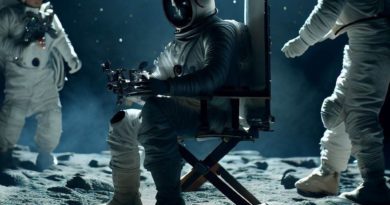‘Apollo 11’ Review – The Antidote To Moon Landing Conspiracy Theories
One of the most jaw-dropping shots in Apollo 11, the revelatory new archive-based documentary about the 1969 moon landing, wasn’t filmed anywhere near the moon. To be exact, it was shot about 250,000 miles away in Houston, Texas.
A slightly wobbly camera held at around knee level looks down a row of perhaps 30 NASA technicians looking intently at computer screens. Most are men in white short-sleeved shirts, some wear long white lab coats. The camera moves up the aisle and toward the back of the room, and more rows of 30-odd technicians flash past. On and on it goes: row upon row upon row of the most revered boffins, poindexters and nerds America has produced.
This content is imported from YouTube. You may be able to find the same content in another format, or you may be able to find more information, at their web site.
By that point in the film you’ve already seen the Saturn V rocket crawling toward its launchpad on a vast transporter, its caterpillar tracks twice the height of the blokes scurrying around beneath it like ants, but it’s the desks that stay with you.
You feel like you know the Apollo story: JFK’s speech about choosing to go to the moon not because it’s easy but because it’s hard; then a snap forward to the astronauts loading into the rocket; Armstrong dropping onto the lunar surface, some photos, then back home in time for a ticker tape parade.
But those are just snapshots. A little like First Man, the goal of Apollo 11 is to retell a story that you know ends in triumph while showing its real terror and jeopardy afresh. It wasn’t for nothing that Richard Nixon had a speech prepped in case the astronauts didn’t make it back, paying tribute to “epic men of flesh and blood” who would be “mourned by a Mother Earth that dared send two of her sons into the unknown”.
The film delivers in spades, thanks in large part to the clarity and scope of fresh 70mm footage dug out of storage especially for the film, as well as judiciously used, era-appropriate graphics to show how the different stages of the mission actually worked. It shows how dangerous and how audacious the moon landings were without repeating the other hundreds of documentaries on the subject, or breaking the tension with empty superlatives from talking heads.
And that’s the other thing Apollo 11 does with a forensic and measured calmness: it proves beyond doubt that while it was almost literally incredible, the moon landings did definitely happen. Clearly, that isn’t a priority. The old Kubrick-on-a-soundstage guff is quite a niche belief these days. But the film seems to go out of its way to wallop you with another look, we actually did it moment every few minutes.
There’s the sequence where Earth gets gradually smaller and smaller in the rear window over the first four days of the mission, and seeing the elemental blast from the Saturn V’s engines close up is staggering. Most pointedly, Armstrong and Aldrin’s final approach to the lunar surface is shown through a single camera’s view through a window. Over five minutes, the moon gradually gets closer and closer. There are no cuts, just an altimeter counting down the feet to the surface. It’s the closest you’ll ever get to knowing how it felt in the lunar lander.
It feels all the more pointed given that the 50th anniversary of the Apollo 11 mission falls at a time when nobody really trusts anything anymore. Granted, nobody should really still be arguing about the moon landings 50 years after they happened. That starship has sailed. It’s like firing up Twitter to moan about not being able to use ha’pennies anymore or flame some nerd who wants Jon Pertwee to follow Patrick Troughton in Doctor Who. But believers still exist – up to six per cent of Americans don’t think the landings happened, according to one poll – and gather in the stupider recesses of Reddit and YouTube to agree with each other about flapping flags.
They’re a very fringe group, but the ‘truthers’ who followed in their conspiratorial path aren’t. Compared to Sandy Hook false flag cranks, climate change deniers, anti-vaxxers and certain floppy-haired no-deal fantasists, the moon landing truthers feel quite quaint. But they’re all on a continuum of disbelief in observable fact, and they’re more numerous and vocal now than they have been for some time. The belief that whoever you disagree with is acting in bad faith and is part of a broader scheme to subjugate you is the starting point of a lot of Twitter arguments.
But that shot of those desks in mission control emphasise the scale of the human effort and ingenuity the moon mission demanded if it was to succeed. Apollo 11 is a powerful and beautiful reminder that sometimes, when people who know what they’re on about have every obstacle swept out of their way, impossible things can happen.
Apollo 11 is in cinemas from 28 June
Like this article? Sign up to our newsletter to get more articles like this delivered straight to your inbox
This content is created and maintained by a third party, and imported onto this page to help users provide their email addresses. You may be able to find more information about this and similar content at piano.io


